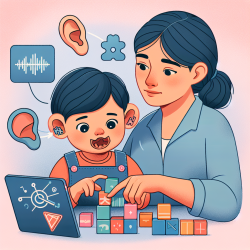As a speech-language pathologist, staying abreast of the latest research is crucial for delivering effective interventions. A recent study titled Spatial Processing Disorder in Children With Cleft Palate offers valuable insights that can enhance your practice. This blog post will summarize the key findings and suggest practical applications for improving outcomes in children with cleft palate.
Understanding Spatial Processing Disorder (SPD)
Spatial Processing Disorder (SPD) is a subtype of Central Auditory Processing Disorder characterized by difficulties in understanding speech in noisy environments, despite normal audiometric results. Children with a history of otitis media are particularly vulnerable to SPD, and this risk is even higher in children with cleft palate.
Key Findings from the Study
The study involved 20 children with cleft palate aged between 6 and 16 years. The following key findings were reported:
- 40% of the children were diagnosed with SPD using the Listening in Spatialized Noise-Sentences (LiSN-S) test.
- 4 additional children exhibited significant signal-to-noise ratio (SNR) losses, affecting speech intelligibility.
- Children who underwent the Listening in Spatialized Noise & Learning (LiSN & Learn) remediation program showed substantial improvements.
Implications for Practice
These findings underscore the importance of early identification and intervention for SPD in children with cleft palate. Here are some practical steps you can take:
- Screening: Regularly screen children with cleft palate for SPD, especially if they have a history of otitis media.
- Diagnosis: Utilize the LiSN-S test to diagnose SPD accurately. This test is effective in differentiating spatial processing abilities from other auditory skills.
- Intervention: Implement the LiSN & Learn remediation program. This computer-based intervention has shown significant improvements in spatial processing abilities.
- Follow-Up: Regular follow-ups are essential to monitor progress and adjust interventions as needed.
Encouraging Further Research
While this study provides valuable insights, further research is needed to explore the long-term benefits of interventions like LiSN & Learn and to develop additional strategies for managing SPD in children with cleft palate. As practitioners, staying engaged with ongoing research will help you provide the best possible care for your patients.
To read the original research paper, please follow this link: Spatial Processing Disorder in Children With Cleft Palate.










